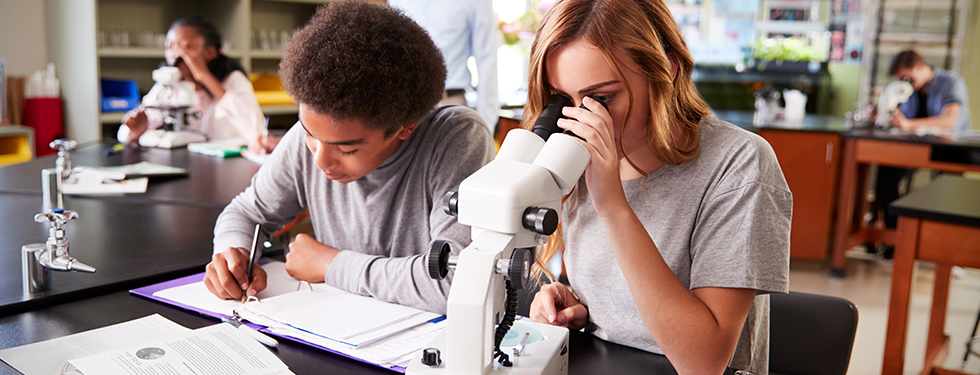
Properly equipping your school with science tables that will withstand your lab activities can quickly become overwhelming if you aren’t familiar with industry terms. So, what exactly is the difference between high-pressure laminate and epoxy resin tops and what do you need for your own lab? Here’s a quick run-down of the differences between the various science lab tabletops, so you can shop for your school with confidence.
High-Pressure Laminate
A science table with a high-pressure laminate (HPL) top is the best option for elementary STEM programs. This material is made through a multi-step process where six to eight layers of resin-infused paper with a clear overlay are combined using high pressure and heat. This material is then permanently bonded to an industrial-grade particle board core.
This thorough process creates a top that is resistant to impacts, scratches and warping, so it’s perfect for technological and physical science activities. For classes that do not use chemicals, laminate science tables are ideal.
Chemical Resistant Laminate
Chemical resistant laminate lab tables have a similar production process with an important added step – a special resin is applied over a high-pressure laminate top. This added layer provides protection against weaker chemicals and low heat sources.
The resistance to heat and chemicals offered by this type of tabletop is suitable for middle school students and other entry-level science labs found in K-12 schools. Chemical resistant laminate tops can withstand a variety of experiments that will spark scientific interest in many students.
Phenolic Resin
As students become more advanced, so should the lab desks they use. These highly durable tables are a great option for science labs in high schools and colleges.
Phenolic resin tabletops are thermo-fused, again under pressure and heat, and have a special coating of phenolic resin that gives this tabletop its name. Phenolic resin is a synthetic polymer that provides protection against chemicals and extreme temperatures.
Experiments that utilize common laboratory chemicals, such as Nitric acid 30% and Sulfuric acid 33%, won’t damage phenolic resin tabletops. This style of top is also waterproof and can even withstand extreme heat and cold from small flames or dry ice.
Epoxy Resin
One of the most resilient options, tabletops manufactured with epoxy resin are extremely durable. Epoxy resin is a type of adhesive that hardens to form a non-porous, solid surface, making it highly resistant to caustic chemicals and extreme temperatures found in normal university and medical laboratories.
These tabletops are difficult to damage, resisting scratches and stains, and they are completely impervious to moisture. Even after years of use, epoxy resin tabletops will look new. These types of science tables are an excellent choice for properly equipping professional-level labs.
No matter what experience you want to provide your students, there are tables to serve your needs. For more information about science lab tables, take a look at our Science & Lab Tables Buying Guide, which outlines other qualities worth considering when purchasing a table. We also have a team of experts ready to answer any questions you may have about materials used, safety requirements and more. Contact us at 1-800-260-2776 or [email protected].



